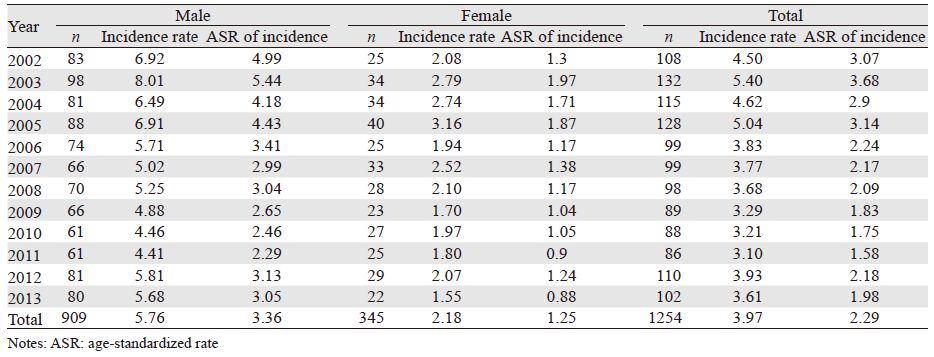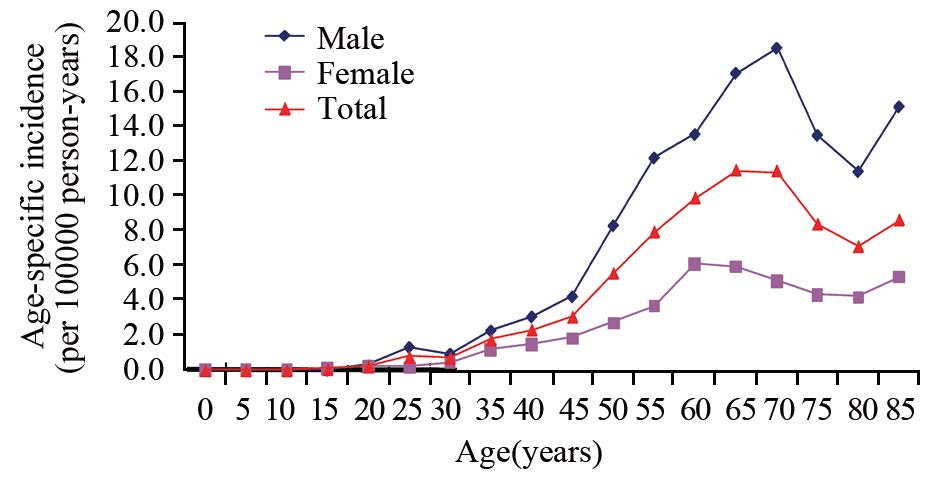文章信息
- 李小攀, 郑晓, 孙乔, 郝莉鹏, 杨琛, 张美玉, 李晓莉, 王莉红.
- LI Xiaopan, ZHENG Xiao, SUN Qiao, HAO Lipeng, YANG Chen, ZHANG Meiyu, LI Xiaoli, WANG Lihong.
- 2002—2013年上海市浦东新区居民鼻咽癌发病情况及其趋势分析
- Trends on Morbidity of Nasopharyngeal Carcinoma Among Residents in Pudong New Area of Shanghai, 2002-2013
- 肿瘤防治研究, 2015, 42(12): 1239-1242
- Cancer Research on Prevention and Treatment, 2015, 42(12): 1239-1242
- http://www.zlfzyj.com/CN/10.3971/j.issn.1000-8578.2015.12.015
-
文章历史
- 收稿日期: 2015-03-18
- 修回日期: 2015-07-14
鼻咽癌(nasopharyngeal carcinoma,NPC)起源于鼻咽部黏膜上皮,其发生主要与EB病毒(Epstein-Barrvirus,EBV)感染、遗传易感性和环境等因素有关[1]。据国际癌症中心数据统计,中国是NPC的高发地区,发病例数约占全世界的80%,是危害我国人民健康和生命安全的主要肿瘤之一[2, 3]。浦东新区是上海市最大的市辖区,随着改革开放的进一步深入,居民的生活习惯和生活环境在几十年内发生了巨大的变化[4]。为了解区域内近年来居民鼻咽癌的发病情况,本研究对浦东新区居民2002—2013年的鼻咽癌发病资料进行流行趋势分析,结果报告如下。
1 资料与方法 1.1 资料来源以上海市浦东新区常住户籍人口为研究对象,对2002年1月1日—2013年12月31日肿瘤登记报告的鼻咽癌发病资料进行研究。各时间段全区人口资料由上海市浦东新区公安分局提供。肿瘤发病资料来自上海市浦东新区疾病预防控制中心肿瘤登记报告系统。发病患者经病理形态学诊断(morphology verified,MV)的比例为85.24%(1069/1254),死亡患者经MV的比例为74.61%(432/579)。死亡补发病,即只有死亡医学证明(death certificate only,DCO)者占肿瘤登记患者数(27/1254)的百分比低于0.5%,整体研究资料的可信程度较高。
1.2 研究方法根据2010年国际疾病分类第10版(The InternationalStatistical Classification of Diseases and RelatedHealth Problems 10th Revision,ICD-10)和2002年国际肿瘤分类第3版(International Classificationof Diseases for Oncology,3rd Edition,ICD-O-3)编码,对所登记的恶性肿瘤发病资料进行编码及分类统计。通过设计好的调查表分别摘取鼻咽癌患者的发病信息,包括姓名、性别、出生年月、家庭地址、肿瘤性质、病理分期、诊断日期、诊断依据和手术治疗情况等资料,以患者首次确诊日期作为观察起点,对2002年1月1日—2013年12月31日新发鼻咽癌患者资料进行分析。
1.3 统计学方法应用SPSS16.0软件对数据资料进行整理和统计学分析。发病率的计算以浦东新区常住户籍人口为基础,各年平均人口数为相邻两年年末人口数的平均值。按不同时间、性别和年龄组分别计算鼻咽癌的发病率,采用1985年世界标准人口年龄构成进行标化。应用Join-point regressionprogram 4.1统计软件进行率值的年均变化百分比(annual percent change,APC)的计算和率值趋势检验。以P<0.05为差异有统计学意义,以上统计学检验均为双侧检验。
2 结果 2.1 发病情况2002—2013年浦东新区共登记报告鼻咽癌新发患者1 254例,其中男909例、女345例,男女发病人数比为2.63:1;按病理类型统计为鳞癌626例、腺癌为13例、其他各类型癌12例、病理未特指603例。平均发病年龄为(60.04±12.95)岁,范围为17~97岁,中位年龄为60岁,占同期全区恶性肿瘤的1.13%(1254/111 024),居同期全区肿瘤发病顺位第20位。男性患者占同期全区男性恶性肿瘤的1.52%(909/59 772),居同期全区男性肿瘤发病顺位第14位;女性患者占同期全区女性恶性肿瘤的0.67%(345/51 252),居同期全区女性肿瘤发病顺位第21位。2002—2013年上海市浦东新区户籍居民合计生存31 590 347人年,其中男性生存15 793 442人年,女性生存15 796 905人年。鼻咽癌合计粗发病率为3.97/10万人年,世界标化发病率为2.29/10万人年;男性粗发病率为5.76/10万人年,世界标化发病率为3.36/10万人年;女性粗发病率为2.18/10万人年,世界标化发病率为1.25/10万人年,见表 1。
 |
2002—2013年浦东新区鼻咽癌发病率变化明显,合计世界标化发病率逐年下降的趋势明显(APC=-5.89%,Z=4.77,P<0.001);男性世界标化发病率逐年下降的趋势明显(APC=-6.19%,Z=4.73,P<0.001);女性世界标化发病率逐年下降的趋势明显(APC=-5.56%,Z=3.87,P=0.003)。
2.3 年龄性别发病情况根据监测数据观察可知,鼻咽癌发病率在15岁前趋近于0,15~70岁时发病率迅速升高,65~69岁时达到最高峰,发病率为11.52/10万人年,随后70~84岁年龄组发病率逐年龄下降,85岁以上时又有所上升。男性鼻咽癌发病率在70~74岁时达到最高峰,发病率为18.56/10万人年;女性鼻咽癌发病率在60~64岁时达到最高峰,发病率为6.17/10万人年,见图 1。

|
| 图 1 2002-2013年浦东新区居民鼻咽癌年龄别发病情况 Figure 1 The age-specialized incidence of nasopharyngeal carcinoma in Pudong New Area of Shanghai, 2002 and 2013 |
本次研究结果显示,2002—2013年上海市浦东新区鼻咽癌世界标化发病率与2003—2007年我国鼻咽发病资料相比,浦东新区远低于全国平均水平(世界标化发病率为3.08/10万人年)[2],更是低于我国广州地区(世界标化发病率为15.8/10万人年)[5],但与上海其他地区[6]、浙江地区数据接近[7]。其主要原因可能与不同地区居民鼻咽癌发病危险因素的暴露水平有关,有研究称华南地区居民的生活习惯与NPC的发生、发展有一定关联,NPC 的家族遗传史和肿瘤遗传易感性在NPC的病因学中也起了关键作用[5, 8]。此外,浦东新区经济及医疗卫生服务较国内大部分地区而言较为发达,更多的医疗卫生投入有可能让居民健康获得更多收益[4]。
浦东新区老龄化十分严重,2002—2013年60岁以上人口比例为20.28%。一般而言,人口老龄化是肿瘤发病率升高的重要原因,而新区鼻咽癌发病率呈逐年下降趋势,其主要原因可能为居民生活习惯改变[9, 10]。欧美国家鼻咽癌低发,浦东新区作为东西方文化的交汇点,居民的生活饮食习惯逐渐“西化”,部分欠发达地区的肿瘤类型发病率可能呈逐渐降低的态势[4, 9]。此外,近十年来,浦东新区大力推进60岁以上老年人免费体检,妇女两癌筛查,大肠癌筛查等项目促进了居民健康观念的改变及提高了肿瘤相关知识知晓率水平,可能也是部分肿瘤发病率降低的原因之一。
本研究由于肿瘤登记牵涉单位或机构较多,患者资料收集不易,按总体死亡补发病例构成为2.15%估计肿瘤发病数可能有漏报的情况存在,发病率可能被低估。此外,患者生存资料及与其生存相关的危险因素需要整理并深入调查,此次分析暂未涉及,值得进一步研究。
综上所述,新区鼻咽癌发病率逐年下降,说明在居民生活环境和习惯改变的基础上鼻咽癌防治取得了一定的效果,同样也说明肿瘤可以预防,增强了未来其他肿瘤可防可治的信心。浦东新区鼻咽癌发病率将来有可能持续下降,提示当地鼻咽癌防治工作需要进一步深化,一定要避免因为鼻咽癌发病率的降低而忽视了鼻咽癌防治工作的重要性。因此,在建议开展相关病因学研究的同时,相关部门应切实引导居民践行健康的生活方式,从而达到防治鼻咽癌的最好效果,带动其他肿瘤防治工作顺利推进。
| [1] | Shen Z, Jiang X, Zeng C, et al. High expression of ubiquitinconjugatingenzyme 2C (UBE2C) correlates with nasopharyngealcarcinoma progression[J]. BMC Cancer, 2013, 13: 192. |
| [2] | Deng W, Huang TR, Chen WQ, et al. Analysis of the incidenceand mortality of nasopharyngeal carcinoma in China between2003 to 2007[J]. Zhong Liu, 2012, 32(3): 189-93. [邓伟, 黄天壬,陈万青, 等. 中国2003-2007年鼻咽癌发病与死亡分析[J]. 肿瘤,2012, 32(3): 189-93.] |
| [3] | Jemal A, Bray F, Center MM, et al. Global cancer statistics[J]. CACancer J Clin, 2011, 61(2): 69-90. |
| [4] | Li XP, Cao GW, Sun Q, et al. Cancer incidence and patientsurvival rates among residents in the Pudong New Area ofShanghai between 2002 and 2006[J]. Chin J Cancer, 2013, 32(9):512-9. |
| [5] | Liu YL, Cao KJ, Ma GS, et al. An analysis of incidence andmortality of nasopharyngeal cancer in Guangzhou city[J].Zhongguo Zhong Liu, 2008, 17(7): 563-4. [刘奕龙, 曹卡加, 马国胜, 等. 广州市鼻咽癌发病率和死亡率分析[J]. 中国肿瘤, 2008,17(7): 563-4.] |
| [6] | Wei KR, Yu YL, Yang YY, et al. Epidemiology of nasopharyngealcarcinoma in china[J]. Shi Yong Yu Fang Yi Xue, 2010, 17(4):828-30. [魏矿荣, 余元龙, 杨有业, 等. 中国鼻咽癌流行概况[J].实用预防医学, 2010, 17(4): 828-30.] |
| [7] | Yao D, Lv HY, Li HZ, et al. Analysis of the status and trend ofnasopharyngeal carcinoma incidence and mortality in cancerregistries of zhejiang province[J]. Zhongguo Er Bi Yan Hou TouJing Wai Ke, 2014, 21(8): 415-7. [姚东, 吕慧洋, 李辉章, 等. 浙江省肿瘤登记地区鼻咽癌发病与死亡现状及趋势分析[J]. 中国耳鼻咽喉头颈外科, 2014, 21(8): 415-7.] |
| [8] | Bao WA, Chen XZ, Hu FJ, et al. The diagnosis and treatment ofnasopharyngeal carcinoma in Zhejiang province: present statusand future challenges[J]. Zhongguo Zhong Liu, 2013, 22(10):771-6. [包婺安, 陈晓钟, 胡福军, 等. 浙江省鼻咽癌诊治现状及挑战[J]. 中国肿瘤, 2013, 22(10): 771-6.] |
| [9] | Ruan HL, Qin HD, Shugart YY, et al. Developing geneticepidemiological models to predict risk for nasopharyngealcarcinoma in high-risk population of China[J]. PLoS One, 2013,8(2): e56128. |
| [10] | Adetifa IM, Antonio M, Okoromah CA, et al. Pre-vaccinationnasopharyngeal pneumococcal carriage in a Nigerian population:epidemiology and population biology[J]. PLoS One, 2012, 7(1):e30548. |
 2015, Vol. 42
2015, Vol. 42


